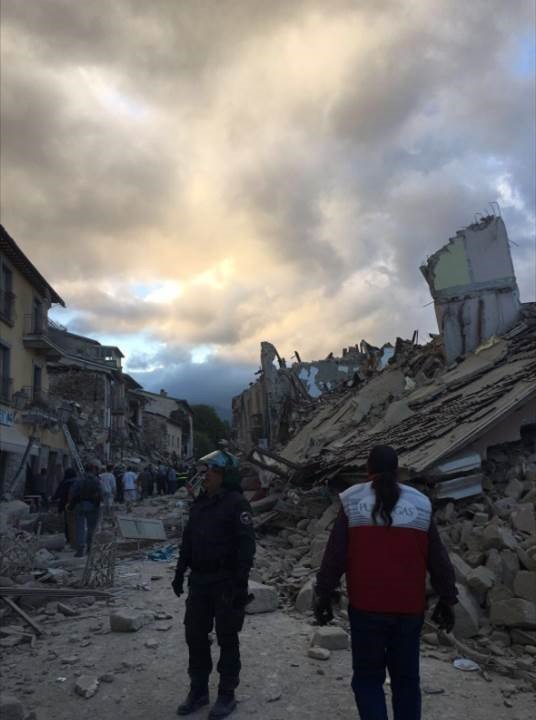An eerie quiet has taken hold over Saletta.
The small settlement of about 20 houses is less than a mile away from the epicenter of a deadly 6.2-magnitude earthquake, which killed at least 247 people, according to Italian authorities.
More than 1,000 people have been displaced by the quake, and Italy’s Civil Protection agency said no residents were allowed to sleep in the devastated town of Amatrice Wednesday night.
Some 264 of those wounded are in the hospital, according to CNN affiliate Rai news.
As the sun rose Thursday in Saletta, it appeared to be a ghost town, CNN contributor Barbie Nadeau said.
The hardest-hit places have proved to be the hardest to access; they’re smaller and older, and many of the roads to get in were affected by the quake.
There have been small glimmers of hope, including a rescue shown on CNN affiliate Sky TG24.
A firefighter in Amatrice clawed at the rubble, trying to get to a little girl.
Suddenly there was a foot, and leg, then the other leg.
The firefighter clutches a girl, Giorgia, said to be 8 years old, and walks her out of the huge pile of rubble as a volley of cheers erupts.
But such scenes appear to be the exception, not the norm.
“We saw unfortunately only bodies pulled out,” Nadeau said. “We didn’t see any happy stories here.”
The numbers
Italy’s Civil Protection agency said of the people killed in the quake, at least 53 of them were in Amatrice, and at least 100 people were injured. Other fatalities were reported in the nearby towns of Accumoli and Arquata del Tronto.
A series of strong aftershocks have been felt since the initial quake, including a 4.7-magnitude tremor that struck a few miles east of Norcia early Thursday morning local time, according to the United States Geological Survey.
The death toll from the quake was expected to rise as rescue teams are continuing to work through the rubble, with regular aftershocks posing a continuing threat.
“Right now we feel terrible pain,” Italian Prime Minister Matteo Renzi said after touring some of the affected areas. “Italy is a family that has been hit and struck, but we are not going to be stopped.”
Addressing the nation Wednesday, Renzi vowed to spare no effort in the critical window following the quake when lives could still be saved.
“In difficult times, Italy knows what to do,” he said.
Hard-to-reach locations
CNN’s Nadeau and her crew escaped injury when a home collapsed behind her in Saletta as she did a Facebook Live session.
Rescue efforts continued through the night, said Luigi D’Angelo, an official with Italy’s Civil Protection Department.
“Many cases have shown in the past that even after two days people can be rescued alive,” he said. “So we want to continue.”
With heavy lifting equipment just starting to reach the isolated village, people used tractors, farm equipment and simple hand tools to break through what was left of old stone villas.
Many settlements are only accessible by small roads, posing a challenge for authorities moving in heavy machinery to the disaster sites.
On a roadside, stunned residents in dust-covered pajamas sought comfort after every aftershock.
Emma Tucker, deputy editor of British newspaper The Times, was in Italy’s Marche region, about 85 kilometers from the epicenter, when her house started “trembling, shaking … an absolutely appalling noise.”
“It felt like someone had put a bulldozer over the house and was trying to knock it down,” she told CNN.
The powerful jolt was felt as far away as Rome, 100 miles from the epicenter.
“It lasted for at least 30 seconds. The entire hotel was shaking,” said Charlotte Smith, coach of Elon University women’s basketball team in North Carolina, who was in Rome with her players when the quake hit.
“It was pretty terrifying,” she said.
The university released a statement later, saying the team was headed back to Charlotte, North Carolina.
Amatrice ‘is no more,’ says mayor
The towns at the epicenter of the quake — Amatrice, Accumoli and Arquata del Tronto — are scenes of devastation, with what were once charming three-story buildings pancaked by the disaster.
Much of the houses in the area — unreinforced brick or concrete frame buildings — were vulnerable to earthquakes, according to the US Geological Survey, and offered little resistance to the powerful temblor.
Amatrice, a town of about 2,000 people in the north of Italy’s Lazio region, is in ruins. But amid the rubble, the town’s clock tower stood tall, with the clock stopped at the time the quake struck.
“The town is no more,” Mayor Sergio Pirozzi told CNN affiliate Rai.
The towns, situated amid remote, mountainous terrain, are particularly popular in the summer with tourists seeking a scenic getaway from the heat of the city.
Red Cross spokesman Tommaso della Longa said the fluctuating population during the vacation season made it hard to know exactly how many people might be trapped in the debris.
Amatrice, known for its traditional all’amatriciana pasta sauce, had been gearing up to hold a festival celebrating the pork jowl, chili and pecorino recipe this weekend, with many visitors expected.
Italy is no stranger to deadly quakes.
In May 2012, a pair of earthquakes killed dozens of people in northern Italy, while in April 2009, a magnitude-6.3 earthquake hit in the Aquila region of central Italy, killing 295. The earthquake Wednesday struck an area close to the 2009 earthquake.
Are you in Italy? Are you affected by the earthquake? If it’s safe for you to do so, WhatsApp us on +44 7435 939 154 to share your photos, experiences and video. Please tag #CNNiReport in your message.
